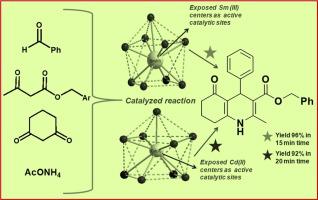当前位置:
X-MOL 学术
›
Inorg. Chem. Commun.
›
论文详情
Our official English website, www.x-mol.net, welcomes your
feedback! (Note: you will need to create a separate account there.)
A study on the catalytic behaviour of Cd(II) and Sm(III) coordination complexes towards the four-component synthesis of quinoline-3-carboxylates
Inorganic Chemistry Communications ( IF 4.4 ) Pub Date : 2020-09-01 , DOI: 10.1016/j.inoche.2020.108084 Kranthi Kumar Gangu , Varalakshmi Pothala , Satya Guru TVSPV , Suresh Maddila , Sreekantha B. Jonnalagadda
Inorganic Chemistry Communications ( IF 4.4 ) Pub Date : 2020-09-01 , DOI: 10.1016/j.inoche.2020.108084 Kranthi Kumar Gangu , Varalakshmi Pothala , Satya Guru TVSPV , Suresh Maddila , Sreekantha B. Jonnalagadda

|
Abstract We report the synthesis two 3-dimensional coordination complexes namely, [Cd(2,5-Pydc)2(H2O)2].H2O (1) [Sm(2,5-Pydc)(NO3)(H2O)].(H2O) (2) using 2,5-Pyridine dicarboxylic acid (2,5-Pydc) as ligand by simple hydrothermal method. Nitrogen and oxygen atoms of 2,5-Pydc provided more scope for the coordination of Cd(II) and Sm(III) ions to the ligand in both the complexes with high dimensionality. The 3D networks of complexes 1 and 2 possessed attractive structures of supramolecular assemblies with good rigidity and high thermal stability. The coordinatively unsaturated metal sites in both 1 and 2 upon activation process generate a Lewis acidic environment. The Lewis acidic nature of complexes 1 and 2 was promptly utilised in the synthesis of novel quinoline-3-carboxylate moieties from the four-component single-pot fusion. Both 1 and 2 showed impressive catalytic activity in the formation of the products in high yield (92-96%) and in a short interval of time (15-25 min.). The complexes 1 and 2 catalysed the Knovenagel condensation between aldehyde and active methylene group, leading to the generation of the reaction intermediate and target products with high selectivity. Optimisation studies confirmed that compound 2 showed superior catalytic activity over 1 due to the strong Lewis-acidic character of Sm(II). The method has potential as a low-cost, high-performance, green protocol for futuristic catalytic applications.
中文翻译:

Cd(II)和Sm(III)配位配合物对喹啉-3-羧酸四组分合成的催化行为研究
摘要 我们报告合成了两种 3 维配位复合物,即 [Cd(2,5-Pydc)2(H2O)2].H2O (1) [Sm(2,5-Pydc)(NO3)(H2O)]。 (H2O) (2) 通过简单的水热法使用 2,5-吡啶二羧酸 (2,5-Pydc) 作为配体。2,5-Pydc 的氮和氧原子为 Cd(II) 和 Sm(III) 离子与高维配合物中的配体配位提供了更多空间。复合物 1 和 2 的 3D 网络具有吸引人的超分子组装结构,具有良好的刚性和高热稳定性。活化过程中 1 和 2 中的配位不饱和金属位点产生路易斯酸性环境。配合物 1 和 2 的路易斯酸性性质被迅速用于从四组分单锅融合合成新型喹啉-3-羧酸酯部分。1 和 2 在以高产率 (92-96%) 和短时间间隔 (15-25 分钟) 形成产物方面都显示出令人印象深刻的催化活性。配合物1和2催化醛与活性亚甲基之间的Knovenagel缩合反应,以高选择性生成反应中间体和目标产物。优化研究证实,由于 Sm(II) 的强路易斯酸性特征,化合物 2 显示出优于 1 的催化活性。该方法具有作为未来催化应用的低成本、高性能、绿色协议的潜力。导致以高选择性生成反应中间体和目标产物。优化研究证实,由于 Sm(II) 的强路易斯酸性特征,化合物 2 显示出优于 1 的催化活性。该方法具有作为未来催化应用的低成本、高性能、绿色协议的潜力。导致以高选择性生成反应中间体和目标产物。优化研究证实,由于 Sm(II) 的强路易斯酸性特征,化合物 2 显示出优于 1 的催化活性。该方法具有作为未来催化应用的低成本、高性能、绿色协议的潜力。
更新日期:2020-09-01
中文翻译:

Cd(II)和Sm(III)配位配合物对喹啉-3-羧酸四组分合成的催化行为研究
摘要 我们报告合成了两种 3 维配位复合物,即 [Cd(2,5-Pydc)2(H2O)2].H2O (1) [Sm(2,5-Pydc)(NO3)(H2O)]。 (H2O) (2) 通过简单的水热法使用 2,5-吡啶二羧酸 (2,5-Pydc) 作为配体。2,5-Pydc 的氮和氧原子为 Cd(II) 和 Sm(III) 离子与高维配合物中的配体配位提供了更多空间。复合物 1 和 2 的 3D 网络具有吸引人的超分子组装结构,具有良好的刚性和高热稳定性。活化过程中 1 和 2 中的配位不饱和金属位点产生路易斯酸性环境。配合物 1 和 2 的路易斯酸性性质被迅速用于从四组分单锅融合合成新型喹啉-3-羧酸酯部分。1 和 2 在以高产率 (92-96%) 和短时间间隔 (15-25 分钟) 形成产物方面都显示出令人印象深刻的催化活性。配合物1和2催化醛与活性亚甲基之间的Knovenagel缩合反应,以高选择性生成反应中间体和目标产物。优化研究证实,由于 Sm(II) 的强路易斯酸性特征,化合物 2 显示出优于 1 的催化活性。该方法具有作为未来催化应用的低成本、高性能、绿色协议的潜力。导致以高选择性生成反应中间体和目标产物。优化研究证实,由于 Sm(II) 的强路易斯酸性特征,化合物 2 显示出优于 1 的催化活性。该方法具有作为未来催化应用的低成本、高性能、绿色协议的潜力。导致以高选择性生成反应中间体和目标产物。优化研究证实,由于 Sm(II) 的强路易斯酸性特征,化合物 2 显示出优于 1 的催化活性。该方法具有作为未来催化应用的低成本、高性能、绿色协议的潜力。











































 京公网安备 11010802027423号
京公网安备 11010802027423号